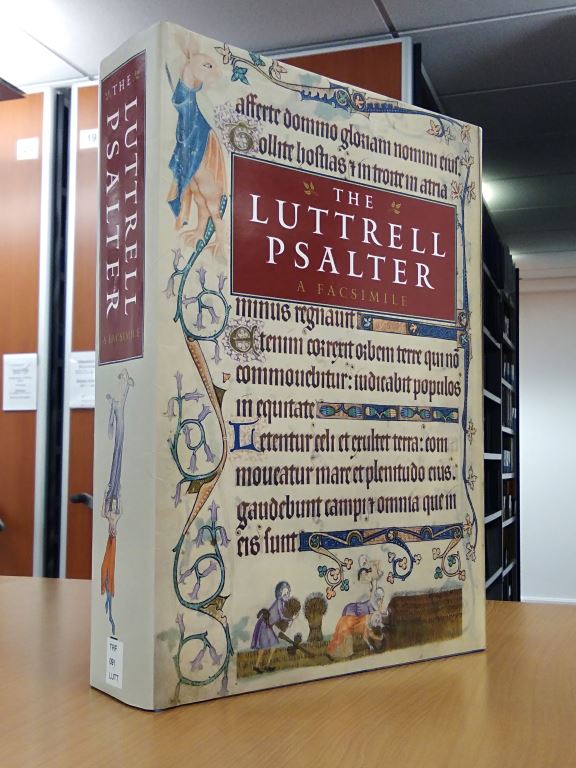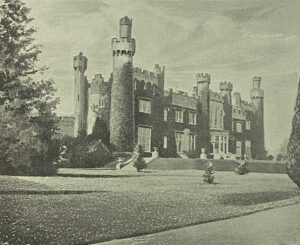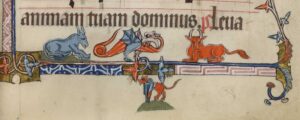The Luttrell Psalter: Knighthood, Hospitality and Piety / Introduction to the Luttrell Psalter
- Elaine Harrington
- January 15, 2019
Student Exhibition, MA in Medieval History
What is a Psalter?
The Psalter is a collection of one-hundred-and-fifty Psalms, written in verse and traditionally attributed to the Old Testament King David. The Psalms express different themes ranging from personal sorrow to jubilation, petition to glorification, communal identity and celebration.
For Christian exegetes who commented on the Bible, the text of the Psalms was regarded as a prefiguration of the life of Christ and his suffering. From early Christian times, the Psalter was used in liturgical services known as the Divine Office, which punctuated the day into eight times of prayer. Monks, canons (clerics living in community under a rule) and friars were obliged to undertake the weekly recitation of more or less the entire Psalter in a complex arrangement divided into the daily offices. These consisted of Matins recited at night, Lauds recited at dawn, Prime, Terce, Sext and Nones which were shorter daytime offices, Vespers recited in the evening, and Compline which was a short bedtime service.
The Psalms also formed the structure of medieval personal piety allowing both ecclesiastics and lay devotees to immerse themselves emotionally in those texts and express their adoration of God, their remorse and reparation for sin, as well as their petition for divine protection. The regular usage of Psalms in personal and public prayers, in Mass readings and the Divine Office, made them a staple of medieval piety. Due to their rhythmic and simple structure Psalters were also used in teaching Latin.

Medieval Psalters: Pride and Piety
UCC’s Special Collections house a facsimile of the richly illuminated Luttrell Psalter alongside facsimiles of other important medieval Psalters. The Luttrell Psalter, British Library, Add. MS 42130 has been held in the British Library since 1929 and is named after its patron Sir Geoffrey Luttrell (1276-1345), a wealthy knight and landowner in Lincolnshire in the north of England, who commissioned this splendid manuscript in the first half of the fourteenth century. His military and noble status, and his religious devotion and personal involvement in the creation of the book, are portrayed through images in the Psalter that are discussed in more detail in other posts of this blog.
Geoffrey’s great-great-grandfather, Geoffrey de Luterel (1158-1218), was a courtier of King John (1199-1216) and established Luttrellstown in Co. Dublin.

When discussing the textual and visual contents of the Luttrell Psalter, it is difficult to separate Sir Geoffrey’s personal piety from family pride, and his spiritual concerns from worldly matters. This great Psalter is simultaneously a statement of his and family’s profound religious devotion and their dynastic aspirations. Psalters as liturgical books were placed on lecterns before the altar for the daily recitation of the Divine Office. The use of the Luttrell Psalter in such a liturgical setting acted as a perpetual remainder of the obligation to pray for the well-being of the patron in life and after death.
The creation of the illustrated Psalter was extremely expensive, but to a medieval benefactor it was a pious investment that secured prayers from the clergy. A close connection between the Luttrells and members of the clergy is seen on folio 208r that depicts two mendicant friars as guests at the dining table of Sir Geoffrey, a scene that is further discussed in another post of this blog. Names of the English and regional saints mentioned in the calendar at the beginning of the manuscript, express similar sentiments: for example, names of Hugh of Lincoln and Thomas Becket stress the Luttrells’ connection to the cathedral city of Lincoln and their devotion to Becket.
What is special about the Luttrell Psalter?
The Luttrell Psalter is unique among medieval manuscripts due to its variety and quantity of illuminations that range from religious representations of Christ and the saints, to the narrative scenes of a secular nature with scenes of rural life and domesticity, to bizarre monsters featuring in the manuscript’s margins.

These strange creatures that inhabit the edges of the Psalter pages can be described as grotesques or marginalia. They are an artistic device that draws the reader’s attention to significant words, themes or even abstract concepts mentioned in the Psalms. We find throughout the Luttrell Psalter, a sequence of illustrations which act as a counterpoint to the text and relate to verses which probably had a devotional value for the patron who commissioned the manuscript.
Liam Costello
Patrick James O’Dwyer
Tomás Miller
Bibliography
Brown, Michelle P., The Luttrell Psalter: A Facsimile, London: The British Library, 2006.
Brown, Michelle P., The World of the Luttrell Psalter, London: The British Library, 2006.
Duffy, Eamon, Marking the Hours, English People and Their Prayers 1240-1570, New Haven, CT: Yale University Press, 2011.
Coss, Peter R., Keen, Maurice H., ed., Heraldry, Pageantry and Social Display in Medieval England, Martlesham: Boydell & Brewer, 2003.
